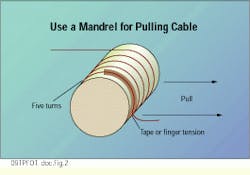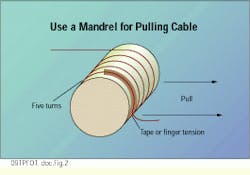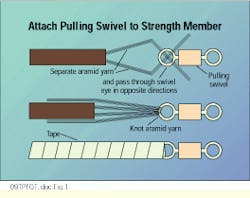Distribute tensile load when pulling fiber
Thomas Dooley, Fiber Specialists Inc. Jerald Rounds, Arizona State University
Problem
The glass fiber within optical-fiber cable is fragile and, although the cable has been designed to protect the fiber, it can be damaged from too much tension during the cable-pulling stage. Because most fiber-optic cable cannot handle high-impact loads, the pulling force on the cable must be kept uniform.
Solution
The design of fiber-optic cable includes a strength member, the purpose of which is to facilitate installation. This member, not the glass fiber, must always be used when tension is placed on the cable during installation. By using a pulling eye, Kellems grip or mandrel, you can distribute the pulling load between the sheath and the Kevlar strength member.
Note: When using power equipment to pull outside-plant cable, tension-monitoring equipment or breakaway swivels must always be used. Power equipment should never be used on inside fiber because the allowable pulling force is so small.
Procedure
1 Always set up the reel so the cable pays off the top (see "Prevent damage to fiber when pulling cable," August 1996, page 48), placing the reel as close as possible to the conduit or innerduct opening. Use the appropriate lubricant for all fiber-optic cable pulls.
2 For cable with aramid yarn as a strength member, attach directly to a pulling eye.
3 If attaching a Kellems grip to the end of the cable, connect it to the pull rope through a swivel. Remove the last 2 feet of sheath, fiber and antibend rod, leaving only the Kevlar pulling yarn. Slide the grip onto the next 2 feet of sheathed cable. Attach the pulling swivel to the Kellems grip loop and tie the leading 2 feet of Kevlar to the pulling swivel to distribute the pulling load between the sheath and Kevlar strength member.
4 For cable using fiberglass, Kevlar or stainless steel embedded within the sheath, put the grip on the sheath. A cutback is not necessary because this sheath acts as the strength member.
5 Wrap the installed grip with vinyl tape, starting on the cable and working up to, but not including, the swivel.
6 Simplex and duplex cable should always be pulled using a pulling rope and swivel.
7 Should it become necessary to continue to pull on the jacket, use a 6-inch diameter mandrel, wrapping five turns of cable. Maintain tension on the first wrap with tape or hold it with your finger. This ensures that force is transferred to the aramid yarn strength member in the same way that a ship`s capstan allows rope to be pulled by friction only--with no attachment to the capstan.
This tip is excerpted and reproduced by permission from Fiber Optics Technician`s Manual authored by Jim Hayes, president of Fotec Inc. in Medford, MA, and published by Delmar Publishers, Albany, NY. Chapter 15, "Fiber Optic Cable Pulling," was written by Thomas Dooley of Fiber Specialists Inc. and Jerald Rounds of Arizona State University, instructors for Fiber U, a fiber-optic training conference presented by Fotec, with input from Northern Lights Cable Inc. in North Bennington, VT.
When using a mandrel, tape the cable end or hold it with your finger and wrap five turns around the mandrel before pulling.
To attach cable strength member to the pulling eye, separate the aramid yarn, pass each strand in opposite directions through and tie it in a knot. Then wrap the installed grip with tape, starting at the cable up to the swivel.


